Abstract
The present study investigated the ability of neuroleptic drugs to induce hypothermia in mice when they were administered intraperitoneally (i.p.) or intracerebroventricularly (i.c.v.). Twelve neuroleptics belonging to five chemical classes including phenothiazines, butyrophenones, benzamides, thioxanthenes and diphenylbutylpiperidines were injected i.p. All of them, except benzamides, induced a dose-dependent decrease in rectal temperature. Neuroleptics were administered i.c.v. via cannulae previously implanted in mice to determine whether this response might have a central origin. None of the drugs tested induced hypothermia at doses which did not produce toxic effects. These negative results suggest that neuroleptics act to elicit hypothermia via a peripheral, rather than a central mechanism. Since some neuroleptics possess alpha-adrenolytic properties which could induce hypothermia by promoting vasodilatation, we attempted to antagonize the hypothermia produced by peripheral administration of two neuroleptics with phenylephrine, an alpha-adrenoceptor agonist that does not cross the blood-brain barrier. The hypothermia induced by both chlorpromazine and haloperidol was attenuated by phenylephrine, supporting the view that peripheral alpha-adrenoceptors may mediate neuroleptic-induced hypothermia.
Full text
PDF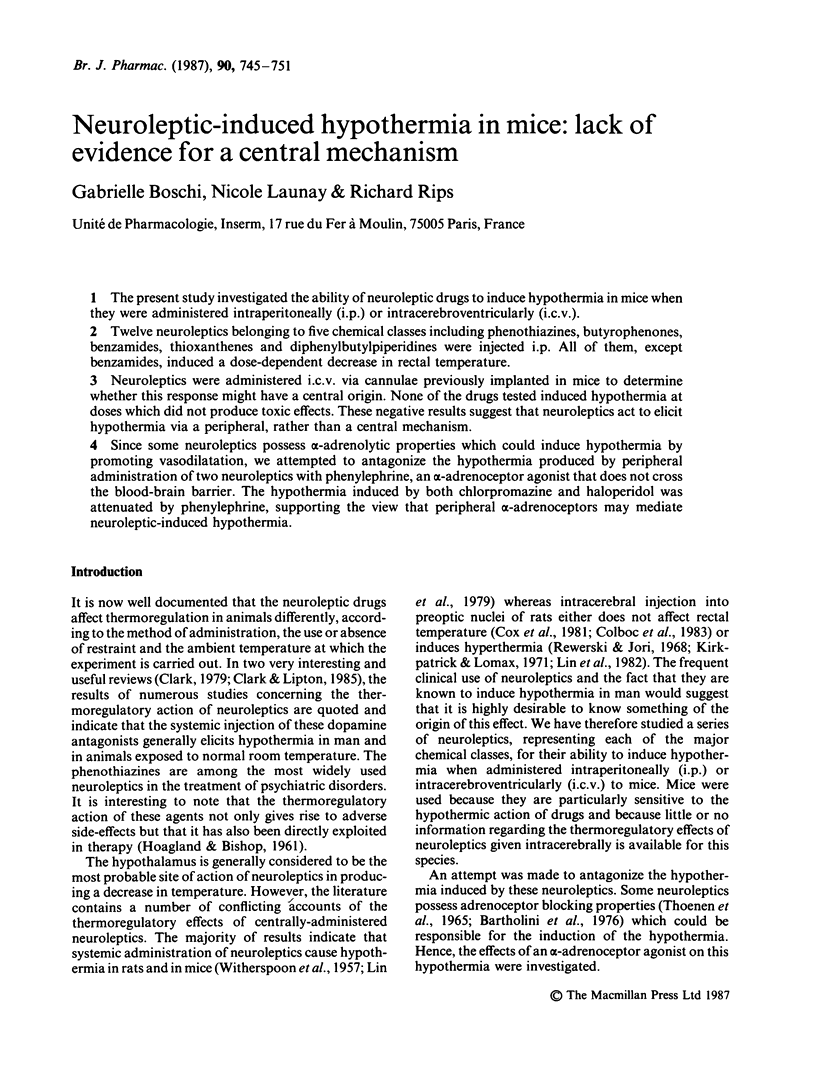
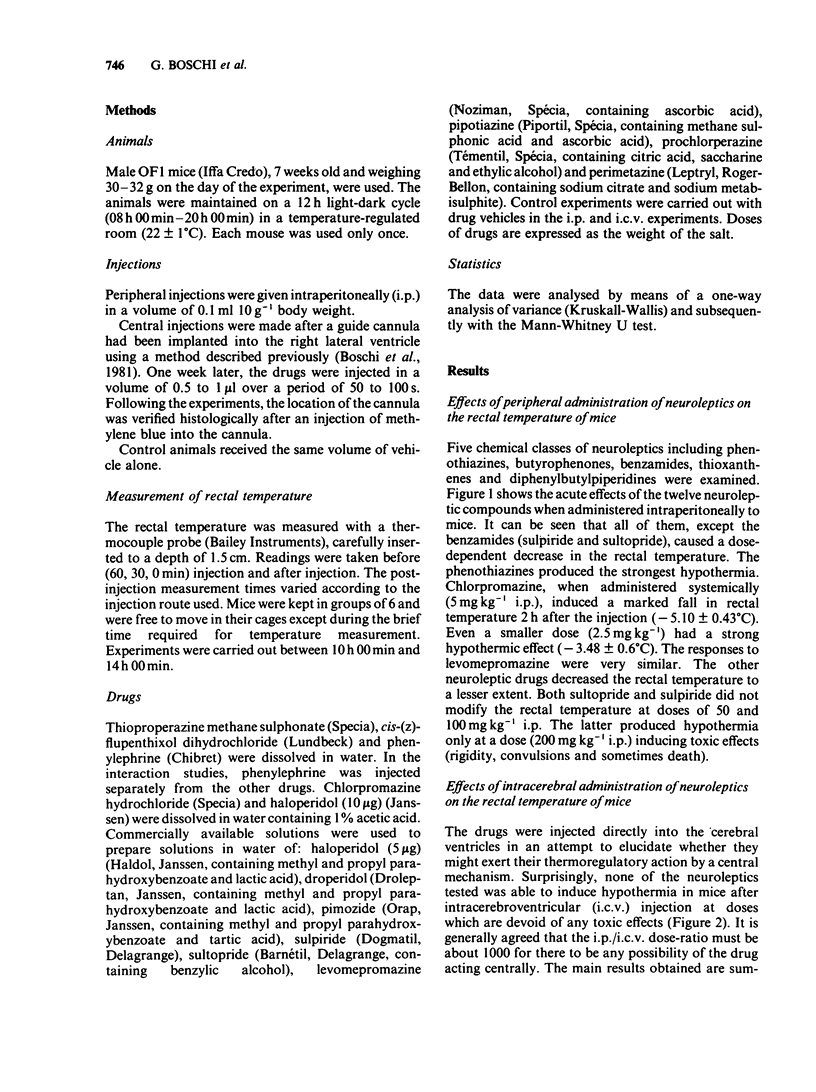
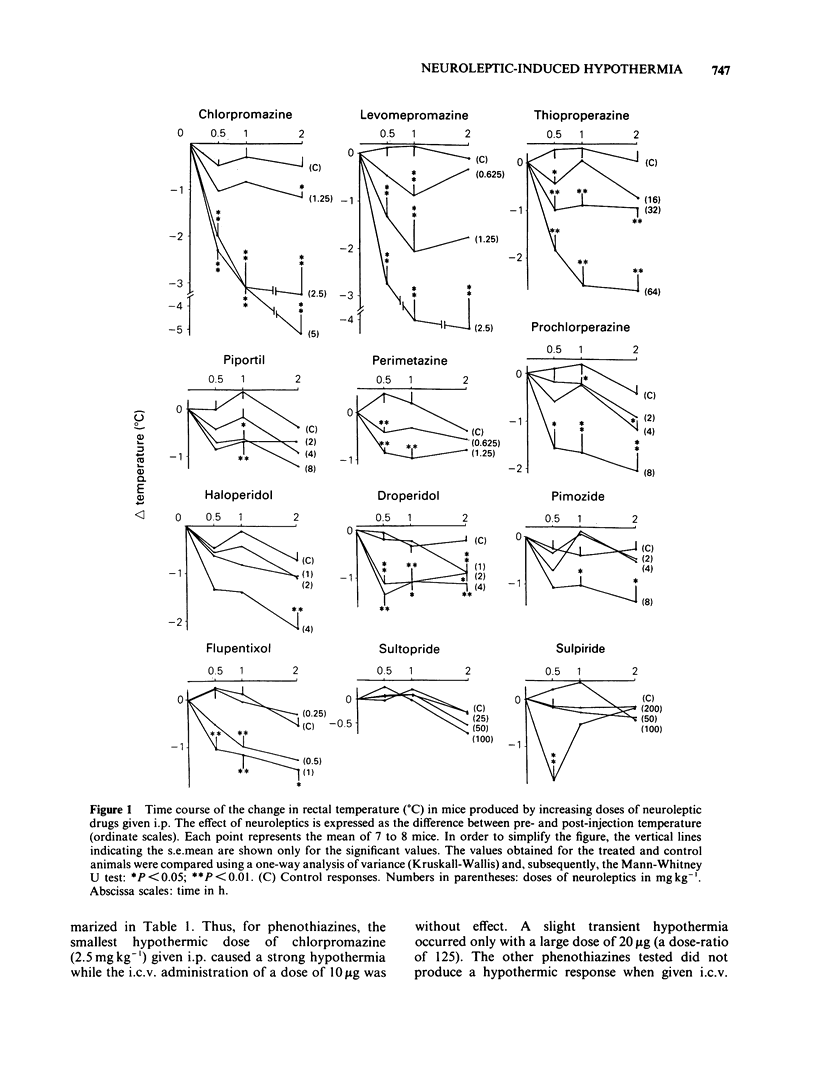
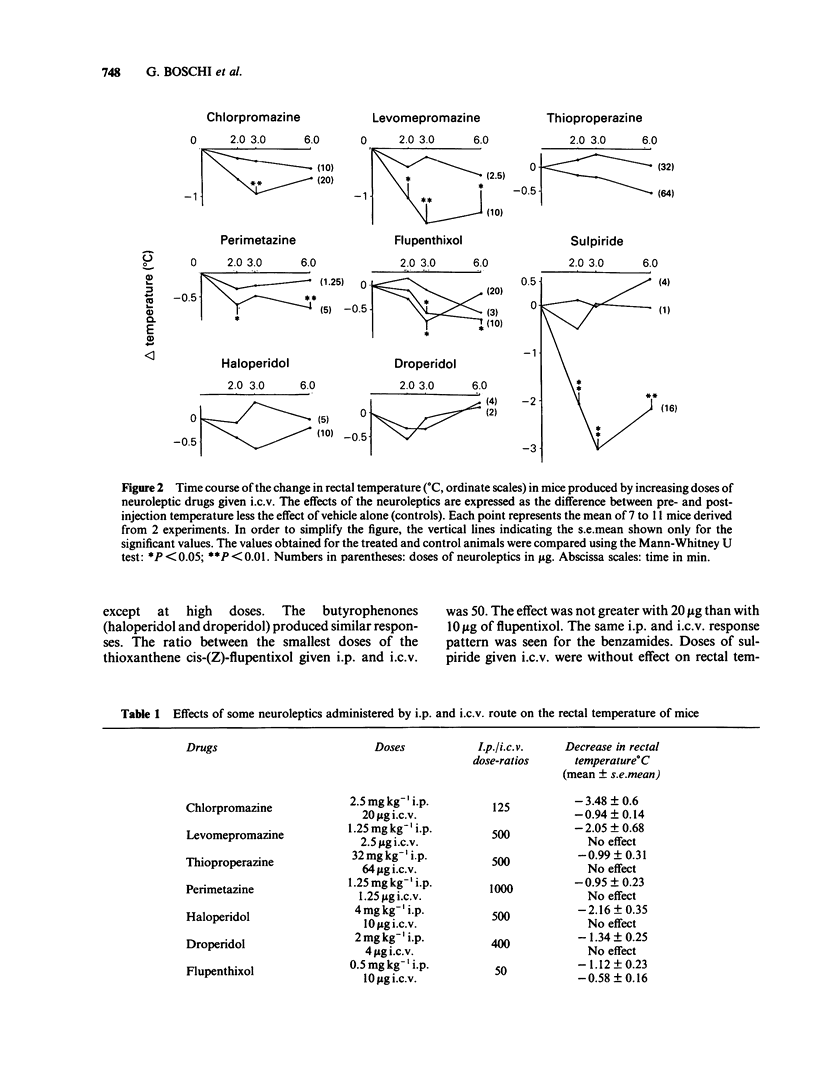
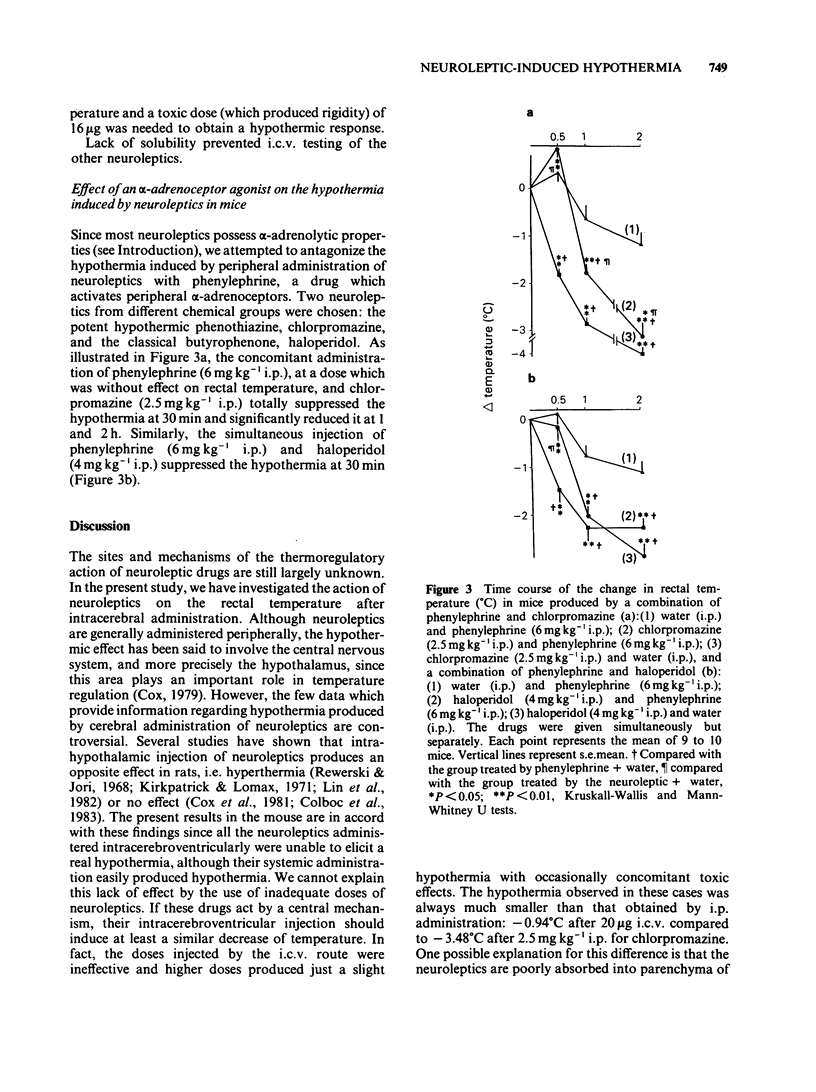
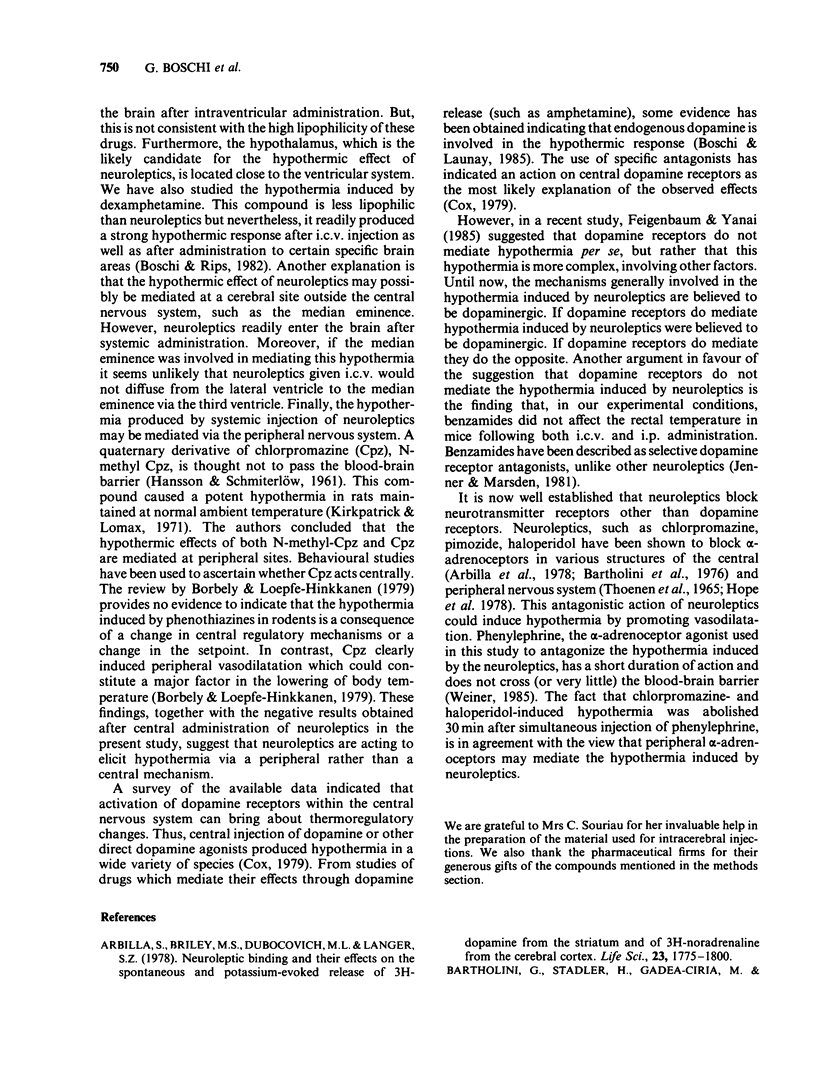
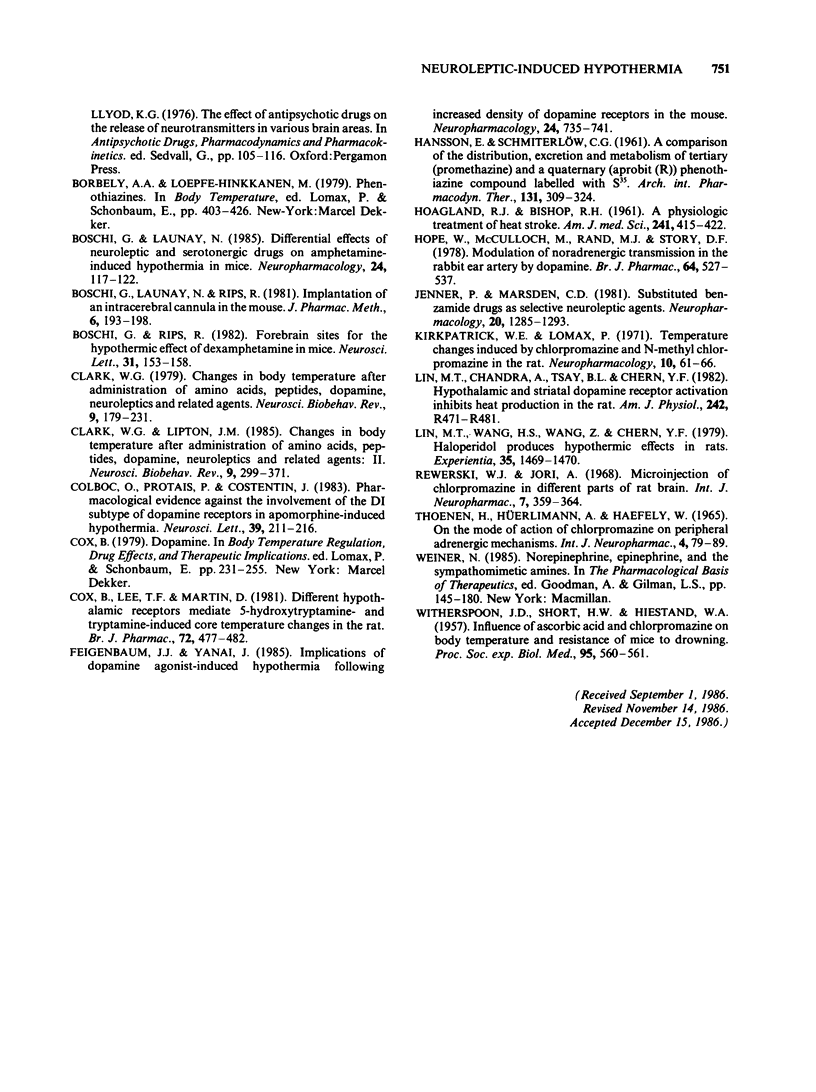
Selected References
These references are in PubMed. This may not be the complete list of references from this article.
- Arbilla S., Briley M. S., Dubocovich M. L., Langer S. Z. Neuroleptic binding and their effects on the spontaneous and potassium-evoked release of 3H-dopamine from the striatum and of 3H-noradrenaline from the cerebral cortex. Life Sci. 1978 Oct 30;23(17-18):1775–1780. doi: 10.1016/0024-3205(78)90107-8. [DOI] [PubMed] [Google Scholar]
- Boschi G., Launay N. Differential effects of neuroleptic and serotonergic drugs on amphetamine-induced hypothermia in mice. Neuropharmacology. 1985 Feb;24(2):117–122. doi: 10.1016/0028-3908(85)90170-4. [DOI] [PubMed] [Google Scholar]
- Boschi G., Launay N., Rips R. Implantation of an intracerebral cannula in the mouse. J Pharmacol Methods. 1981 Nov;6(3):193–198. doi: 10.1016/0160-5402(81)90108-x. [DOI] [PubMed] [Google Scholar]
- Boschi G., Rips R. Forebrain sites for the hypothermic effect of dexamphetamine in mice. Neurosci Lett. 1982 Aug 16;31(2):153–158. doi: 10.1016/0304-3940(82)90108-2. [DOI] [PubMed] [Google Scholar]
- Clark W. G. Changes in body temperature after administration of amino acids, peptides, dopamine, neuroleptics and related agents. Neurosci Biobehav Rev. 1979 Winter;3(4):179–231. doi: 10.1016/0149-7634(79)90010-1. [DOI] [PubMed] [Google Scholar]
- Clark W. G., Lipton J. M. Changes in body temperature after administration of amino acids, peptides, dopamine, neuroleptics and related agents: II. Neurosci Biobehav Rev. 1985 Summer;9(2):299–371. doi: 10.1016/0149-7634(85)90052-1. [DOI] [PubMed] [Google Scholar]
- Colboc O., Protais P., Costentin J. Pharmacological evidence against the involvement of the D1 subtype of dopamine receptors in apomorphine-induced hypothermia. Neurosci Lett. 1983 Aug 29;39(2):211–216. doi: 10.1016/0304-3940(83)90079-4. [DOI] [PubMed] [Google Scholar]
- Cox B., Lee T. F., Martin D. Different hypothalamic receptors mediate 5-hydroxytryptamine- and tryptamine-induced core temperature changes in the rat. Br J Pharmacol. 1981 Mar;72(3):477–482. doi: 10.1111/j.1476-5381.1981.tb10999.x. [DOI] [PMC free article] [PubMed] [Google Scholar]
- Feigenbaum J. J., Yanai J. Implications of dopamine agonist-induced hypothermia following increased density of dopamine receptors in the mouse. Neuropharmacology. 1985 Aug;24(8):735–741. doi: 10.1016/0028-3908(85)90007-3. [DOI] [PubMed] [Google Scholar]
- HANSSON E., SCHMITERLOW C. G. A comparison of the distribution, excretion and metabolism of a tertiary (promethazine) and a quaternary (Aprobit) phenothiazine compound labelled with S35. Arch Int Pharmacodyn Ther. 1961 May 1;131:309–324. [PubMed] [Google Scholar]
- HOAGLAND R. J., BISHOP R. H., Jr A physiologic treatment of heat stroke. Am J Med Sci. 1961 Apr;241:415–422. doi: 10.1097/00000441-196104000-00001. [DOI] [PubMed] [Google Scholar]
- Hope W., McCulloch M. W., Rand M. J., Story D. F. Modulation of noradrenergic transmission in the rabbit ear artery by dopamine. Br J Pharmacol. 1978 Dec;64(4):527–537. doi: 10.1111/j.1476-5381.1978.tb17314.x. [DOI] [PMC free article] [PubMed] [Google Scholar]
- Jenner P., Marsden C. D. Substituted benzamide drugs as selective neuroleptic agents. Neuropharmacology. 1981 Dec;20(12B):1285–1293. [PubMed] [Google Scholar]
- Kirkpatrick W. E., Lomax P. Temperature changes induced by chlorpromazine and N-methyl chlorpromazine in the rat. Neuropharmacology. 1971 Jan;10(1):61–66. doi: 10.1016/0028-3908(71)90009-8. [DOI] [PubMed] [Google Scholar]
- Lin M. T., Chandra A., Tsay B. L., Chern Y. F. Hypothalamic and striatal dopamine receptor activation inhibits heat production in the rat. Am J Physiol. 1982 May;242(5):R471–R481. doi: 10.1152/ajpregu.1982.242.5.R471. [DOI] [PubMed] [Google Scholar]
- Lin M. T., Wang H. S., Wang Z., Chern Y. F. Haloperidol produces hypothermic effects in rats. Experientia. 1979 Nov 15;35(11):1469–1470. doi: 10.1007/BF01962790. [DOI] [PubMed] [Google Scholar]
- Rewerski W. J., Jori A. Microinjection of chlorpromazine in different parts of rat brain. Int J Neuropharmacol. 1968 Jul;7(4):359–364. doi: 10.1016/0028-3908(68)90018-x. [DOI] [PubMed] [Google Scholar]
- THOENEN H., HUERLIMANN A., HAEFELY W. ON THE MODE OF ACTION OF CHLORPROMAZINE ON PERIPHERAL ADRENERGIC MECHANISMS. Int J Neuropharmacol. 1965 Apr;4:79–89. doi: 10.1016/0028-3908(65)90031-6. [DOI] [PubMed] [Google Scholar]
- WITHERSPOON J. D., SHORT H. W., HIESTAND W. A. Influence of ascorbic acid and chlorpromazine on body temperature and resistance of mice to drowning. Proc Soc Exp Biol Med. 1957 Jul;95(3):560–561. doi: 10.3181/00379727-95-23290. [DOI] [PubMed] [Google Scholar]


